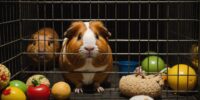How to Provide the Best Habitat for a Guinea Pig's Breed
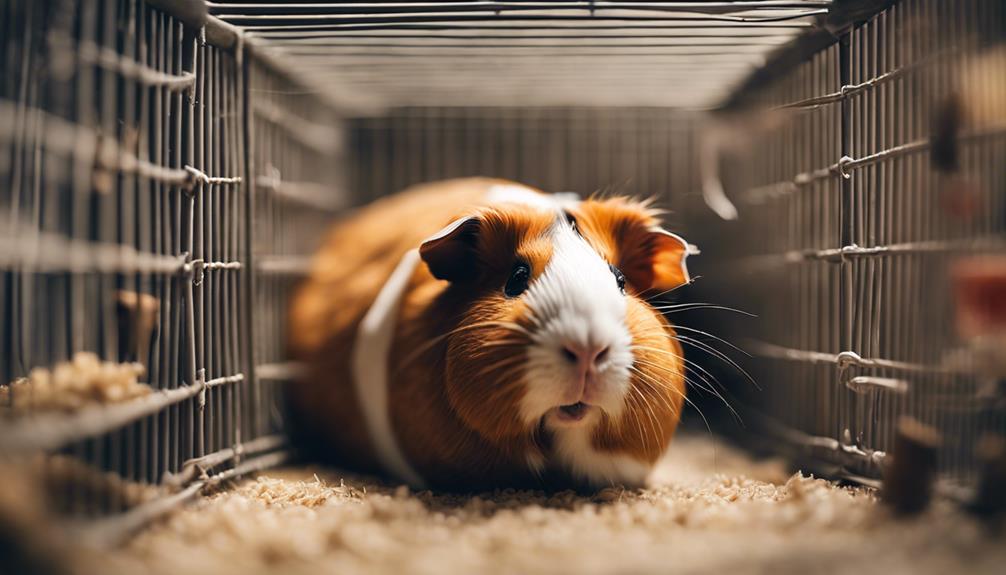
Guinea pigs are social and active animals that require a spacious and stimulating environment to thrive. When setting up their habitat, it's essential to consider their needs for exercise, social interaction, and mental stimulation.
A suitable cage for a guinea pig should be large enough to allow for ample movement. A minimum of 7.5 square feet of space is recommended for one guinea pig, with additional space needed for each additional pig. The cage should have solid flooring to protect their delicate feet and be equipped with safe bedding material such as hay or wood shavings.
Guinea pigs also benefit from having hiding spots and tunnels in their habitat to provide a sense of security. Additionally, including toys and objects for them to chew on can help keep their teeth healthy and prevent boredom.
Incorporating a variety of fresh vegetables and hay into their daily diet is crucial for their health. Providing a water bottle with clean, fresh water at all times is also essential.
Regular cleaning and maintenance of the habitat are necessary to ensure a healthy environment for your guinea pig. This includes removing soiled bedding, cleaning food and water dishes, and spot-cleaning the cage regularly.
By creating a habitat that meets their physical and mental needs, you can ensure that your guinea pig lives a happy and healthy life.
Choosing the Right Cage Size
Selecting an appropriate cage size is crucial to ensuring the well-being and comfort of guinea pigs in their habitat. For a single guinea pig, a minimum cage size of 30 by 36 inches is recommended to provide enough room for movement and enrichment activities. Larger cages are advantageous as they enable guinea pigs to engage in natural behaviors such as running, playing, and exploring, promoting their overall health and well-being. When housing multiple guinea pigs together, the cage size should be increased accordingly to accommodate the social interactions and dynamics within the group.
Choosing a C&C (Cubes and Coroplast) cage is a popular option among guinea pig owners due to its customizable size and design features. These cages offer the flexibility to adjust the space based on the number of guinea pigs and their individual needs. Additionally, proper ventilation is essential in a guinea pig cage to ensure a fresh and healthy living environment. Adequate ventilation helps prevent the build-up of ammonia from urine and ensures good air circulation, contributing to the overall welfare of the guinea pigs.
Selecting Suitable Bedding Material
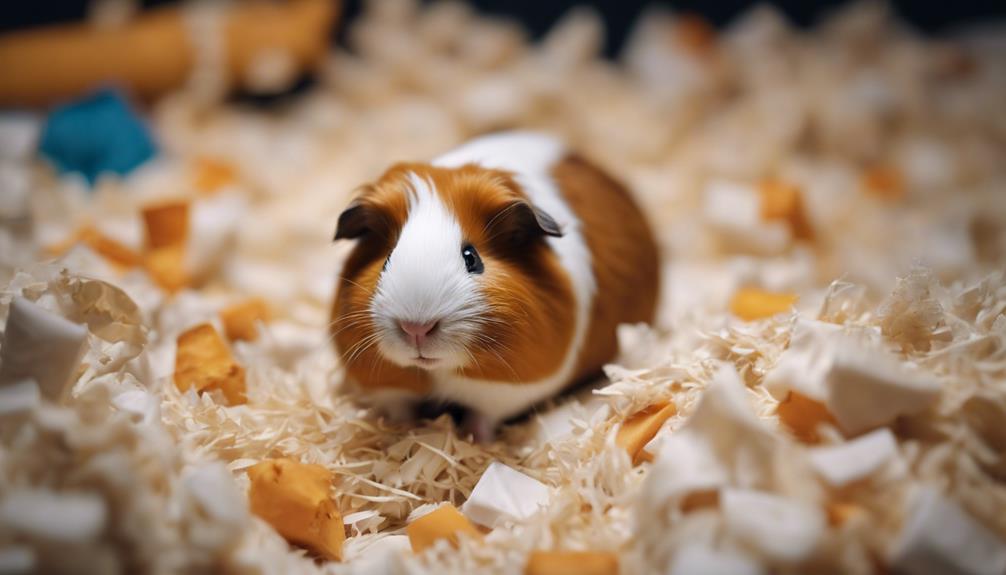
For optimal respiratory health and comfort of guinea pigs, it's advisable to choose paper-based bedding as it helps prevent respiratory issues associated with other materials. When selecting bedding material for guinea pigs, it's crucial to provide 2-3 inches of paper bedding in their habitat. Paper bedding is an excellent choice as it's safe, absorbent, and comfortable for guinea pigs, helping to maintain hygiene in their living environment.
It is important to avoid cedar and pine shavings as they contain harmful chemicals that can negatively impact the respiratory system of guinea pigs. Opting for paper bedding will ensure that your guinea pig isn't exposed to these risks. By choosing paper-based bedding, you're prioritizing the well-being of your pet and creating a safe and comfortable space for them to thrive.
Optimal Temperature and Lighting Conditions
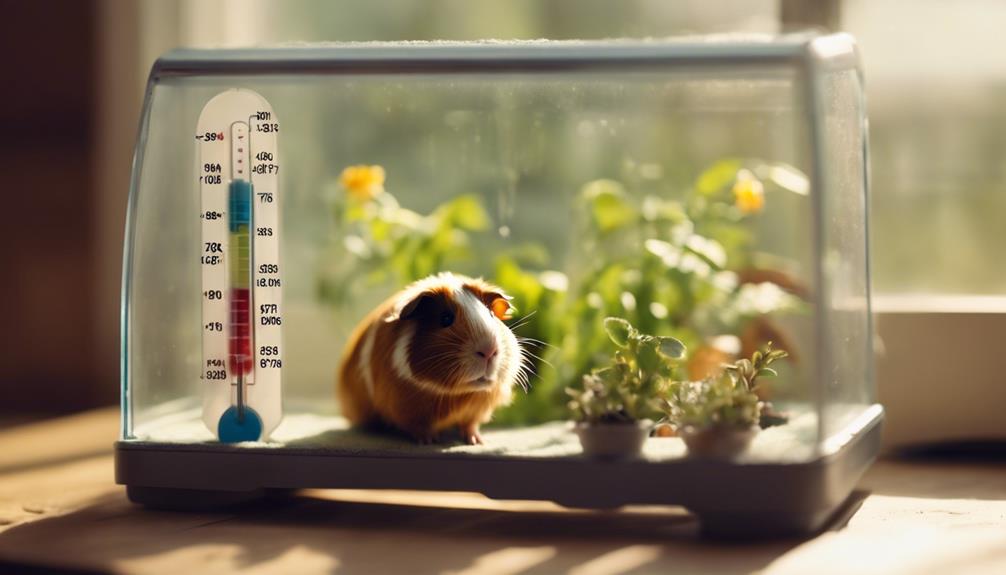
To ensure the optimal health and well-being of guinea pigs, maintaining a temperature range of 65-75 degrees Fahrenheit is crucial, along with providing a consistent 12-hour day-night lighting cycle to regulate their natural rhythms. Guinea pigs are sensitive creatures that thrive in moderate temperatures and a regular light-dark cycle. Here are three key points to consider for their habitat:
- Ideal Temperature Range: Keeping the temperature between 65-75 degrees Fahrenheit creates a comfortable environment for guinea pigs. Extreme temperatures above 80 degrees Fahrenheit or below 60 degrees Fahrenheit can induce stress and negatively impact their health.
- Consistent Lighting Cycle: A 12-hour day-night lighting cycle mimics their natural habitat and helps regulate their internal clocks. This consistency is vital for their overall well-being and behavior.
- Avoid Direct Sun Exposure: Guinea pigs should be kept away from direct sunlight to prevent overheating and potential skin issues. Providing a shaded area in their habitat is essential to protect them from excessive heat and harmful UV rays.
Proper temperature control and lighting management are essential factors in creating a healthy and comfortable living space for guinea pigs.
Ensuring Proper Ventilation and Air Quality
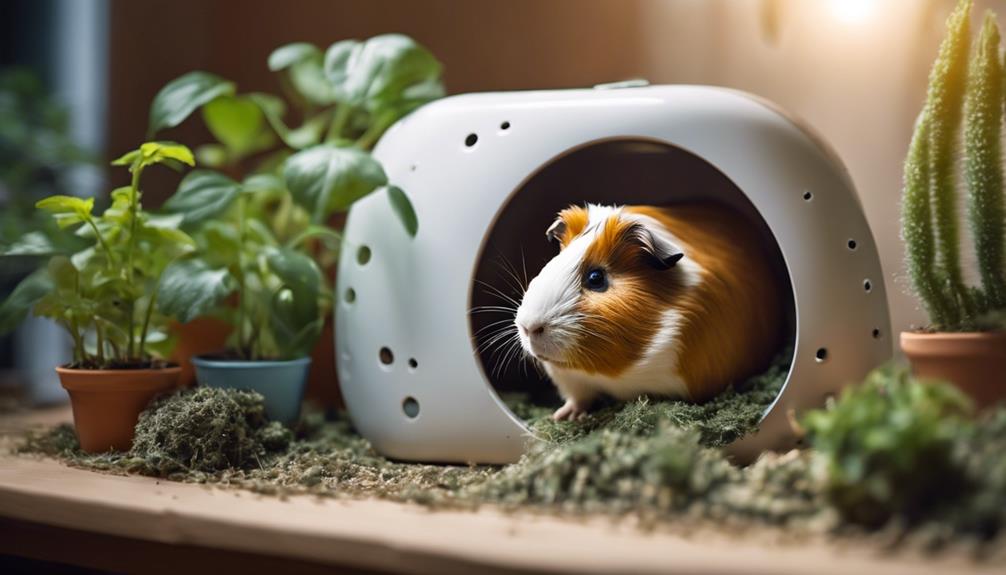
Ensuring proper ventilation and air quality is crucial for maintaining the health and well-being of guinea pigs in their habitat. Guinea pigs are prone to respiratory issues, making good ventilation essential. Proper ventilation helps prevent the buildup of harmful ammonia from urine and feces, controls humidity levels, and inhibits mold growth, all of which can be detrimental to guinea pigs. It is vital to ensure that the cage design allows for sufficient airflow without causing drafts that could stress the guinea pigs. Adequate ventilation supports their respiratory function and overall comfort.
| Ventilation Tips | Benefits |
|---|---|
| Provide good airflow | Prevents respiratory problems |
| Avoid drafts | Reduces stress levels |
| Control humidity levels | Inhibits mold growth |
| Regularly clean the enclosure | Maintains good air quality |
Providing Environmental Enrichment Activities
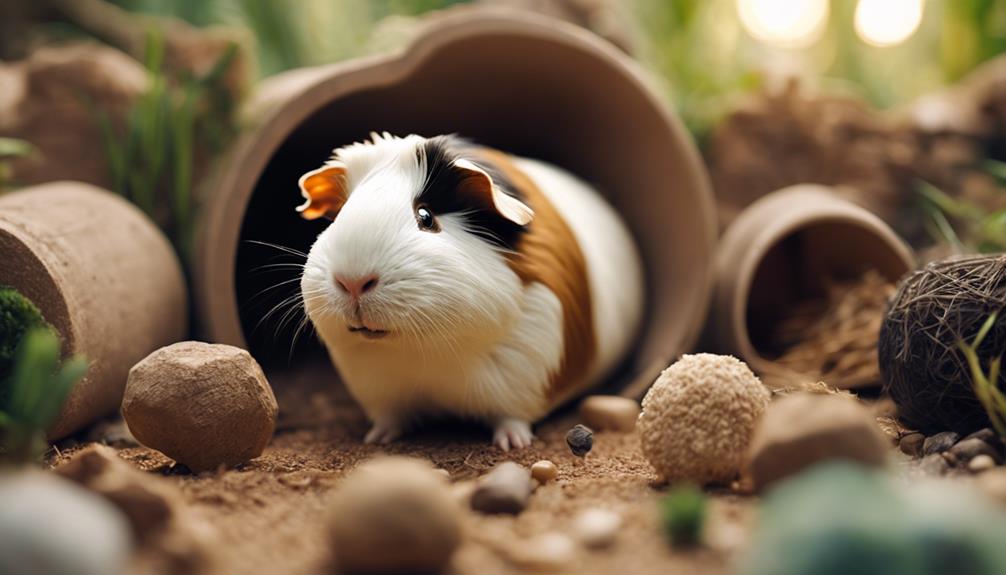
Introducing a variety of environmental enrichment activities is essential for ensuring the mental and physical well-being of guinea pigs in their habitat. Guinea pigs are social creatures that thrive on stimulation and interaction. To ensure your guinea pigs lead fulfilling lives, consider the following types of enrichment:
- Social Interaction: Guinea pigs are highly social animals and benefit greatly from companionship. Consider providing your guinea pig with a same-sex cage mate to prevent loneliness and encourage natural social behaviors.
- Exploration Toys: Include a variety of toys like chew sticks, tunnels, and balls in their habitat to encourage exploration and physical activity. These toys not only provide mental stimulation but also help maintain dental health through gnawing.
- Foraging Opportunities: Stimulate your guinea pig's natural instincts by incorporating foraging opportunities. Hide treats in hay or use puzzle feeders to encourage mental engagement and prevent boredom.
Offering Nutritious Food and Fresh Water
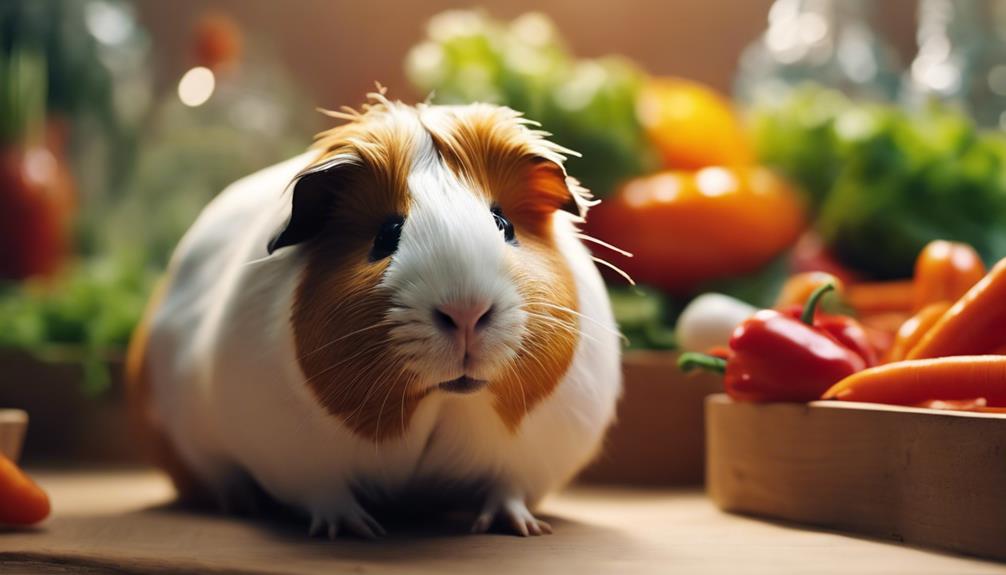
Guinea pigs' well-being is closely tied to the provision of a balanced diet and access to fresh water, essential for maintaining their health and vitality. To ensure a nutritious diet, offer high-quality hay, fresh vegetables, and a small amount of pellets to meet their nutritional needs.
It's crucial to provide enough vitamin C daily through fresh fruits and vegetables to prevent scurvy, a common health issue in guinea pigs. Clean, fresh water should always be available to keep your guinea pig hydrated and maintain their overall well-being.
Avoid giving sugary treats and foods high in calcium to prevent obesity and urinary tract issues. For specific dietary recommendations tailored to your guinea pig's breed and individual needs, consult with a veterinarian or exotic animal specialist.
Regular Cleaning and Maintenance Practices
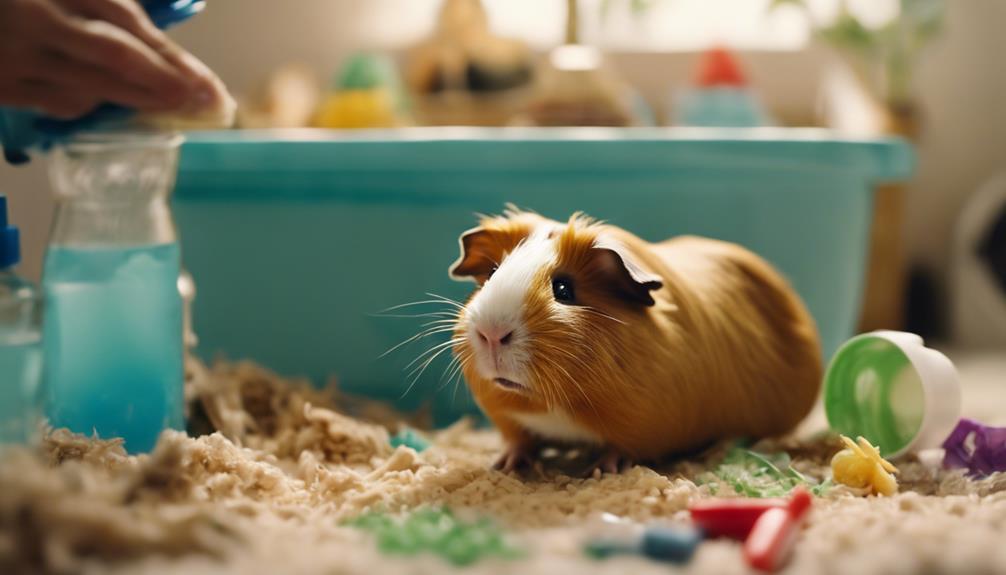
Maintaining a clean and hygienic environment through regular cleaning practices is essential for the well-being of your guinea pig. To ensure a good habitat for your furry friend, follow these tips:
- Use Guinea-Pig Safe Supplies: Regular cleaning with safe supplies is crucial to prevent any harm to your guinea pig and maintain a healthy living space.
- Replace Bedding: Daily spot checks and frequent bedding replacement are necessary to prevent skin issues, maintain cleanliness, and provide a comfortable resting space for your guinea pig.
- Thorough Cleaning: Weekly deep cleaning and monthly thorough cleaning sessions are vital for overall hygiene and to ensure a good environment for your guinea pig to thrive.
Frequently Asked Questions
What Is the Best Habitat for a Guinea Pig?
A guinea pig's best habitat includes temperature control, safe bedding options like dye-free paper, and playtime activities. It should provide ample space for movement, toys for enrichment, and a cozy shelter to ensure comfort and well-being.
How Do You Set up a Guinea Pig Habitat?
Crafting a cozy cage setup for a guinea pig involves selecting spacious quarters, suitable bedding, and snug hideaway spots. Ventilation and temperature control play vital roles in ensuring a comfortable habitat, promoting freedom and well-being.
What Is the Best House for a Guinea Pig?
When considering the best house for a guinea pig, the options include spacious cages with shelters, toys, and hiding spots for enrichment. Opt for dye-free paper bedding at a 2-inch depth, avoiding pine and cedar beddings.
How to Breed Guinea Pigs Safely?
Breeding guinea pigs safely involves understanding proper breeding practices, considering genetics, and prioritizing health and care. Responsible ownership means monitoring for pregnancy, providing appropriate nesting materials, and consulting with veterinarians to ensure ethical breeding practices.







